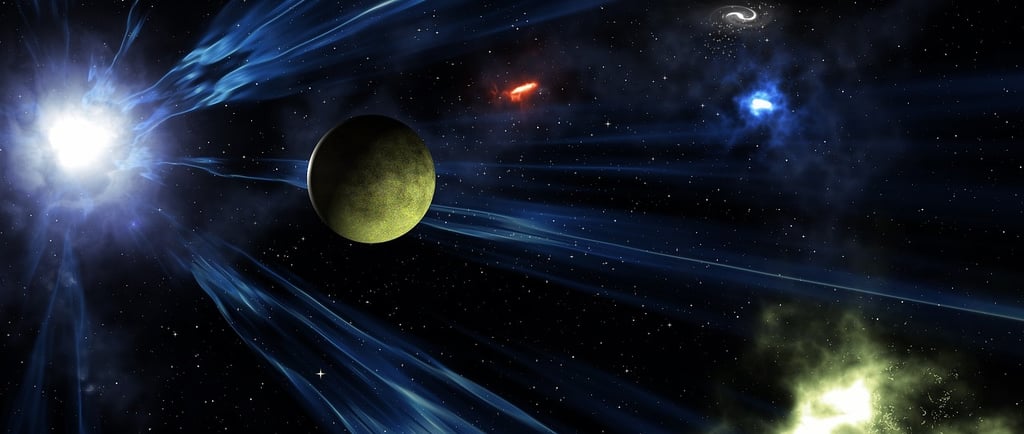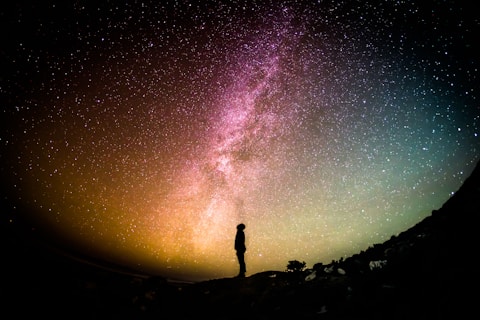
Birth of the Cosmos: Indian Philosophical Insights into Creation
At the intersection of silence and creation, Indian thought reveals the timeless process by which the cosmos is birthed, guided by cosmic law and divine intention, where each moment of existence flows in perfect harmony with the universe’s sacred rhythm.


In the beginning, before time or space existed, there was only the vast, infinite Shunya, the Void—silent, still, and all-encompassing. It was within this void that the seeds of creation lay dormant, waiting for the moment of cosmic birth. This profound moment, according to the Brahmanda myth, marks the origin of everything—the birth of the universe from a cosmic egg, symbolizing the endless cycle of creation, preservation, and dissolution. The Brahmanda, or "cosmic egg," holds within it the entire potential of the universe. It is both a physical and metaphysical entity, containing everything that exists within the cosmos, from the smallest particles to the vast galaxies.
This myth is not simply a creation story; it is a profound exploration of existence itself, encompassing the birth of consciousness, the unfolding of time, and the unfolding of divine order. It is a story of how everything comes into being, how it is sustained, and how it will one day dissolve back into the infinite, cyclical dance of the cosmos. The Brahmanda is simultaneously the seed of the universe and the vessel that contains it, a reflection of Brahman, the supreme consciousness that transcends and pervades all creation.
The Cosmic Egg: A Symbol of Unity
The cosmic egg symbolizes the unity of existence. Within its undivided essence lies the potential for all of creation. It is a potent symbol of Brahman, the singular source from which all things emanate and to which they will ultimately return. Brahman, in Hindu philosophy, is formless, timeless, and beyond human comprehension, but within the cosmic egg lies the promise of all that is visible, perceptible, and knowable. This egg is the space where all dualities dissolve—light and dark, form and formlessness, time and eternity. Within this unity, the vastness of the universe is born.
The splitting of the Brahmanda is the moment when consciousness moves from the undifferentiated state to manifestation. It is in this moment that Brahma, the Creator, emerges from the egg to give form to the universe. But this act of creation is not just about shaping physical matter; it is about organizing the formless void into an ordered universe, imbued with consciousness and rhythm. The universe is birthed as a living, breathing entity, filled with intelligence and purpose. It is a deliberate manifestation of divine will, not a random event, and it unfolds according to a divine plan—an eternal and perfect law that governs all things.
Rta: The Cosmic Law of Order
At the heart of the Brahmanda myth lies the concept of Rta, (pronounced as “rita”) the cosmic order. Rta is the eternal principle that governs not only the heavens and the natural world but also the ethical and moral dimensions of life. It is the law that holds the universe together, ensuring that everything in existence—from the movement of the planets to the actions of human beings—follows a rhythm, a pattern, a divine law. Rta can be understood as both the physical forces that sustain the universe and the moral law that governs the conduct of human beings. It is the fundamental principle of truth, harmony, and righteousness, which ensures the balance of the cosmos.
The importance of Rta is deeply philosophical. It asserts that the universe is not a chaotic, random place but a world of order and purpose, where every action, every motion, every event is part of a larger, divine plan. Rta’s influence permeates everything—from the cycles of day and night, the turning of the seasons, and the rhythms of nature to the way humans interact with each other and the world. In the cosmic scheme, everything plays its role according to the divine law of Rta. This principle laid the foundation for dharma, the moral code or duty, which guides individuals on how to live in harmony with the natural order.
Creation as a Divine Rhythm: The Role of the Divine Triad
The emergence of the universe is not a one-time event but an ongoing process of transformation. This is where the divine triad of Brahma, Vishnu, and Shiva comes into play. Each represents a critical stage in the cycle of creation, preservation, and dissolution—the eternal dance that sustains the universe.
Brahma, the Creator, brings the universe into being, shaping the cosmos from the primal elements of the Brahmanda. His task is to bring order to chaos, to give form and structure to the formless void. He is the architect of the world, breathing life into it and setting it on a course of unfolding reality.
Vishnu, the Preserver, ensures that the cosmos continues in a state of balance and harmony. He maintains the structure created by Brahma, watching over the universe to ensure that Rta is upheld. His role is to sustain the rhythm of creation, ensuring that it flows in an orderly and balanced manner.
Shiva, the Destroyer, plays the crucial role of dissolution, ensuring that the universe is periodically destroyed so that new creation can emerge. This destruction is not to be feared; rather, it is a natural part of the cosmic process, paving the way for regeneration. Shiva's destructive power is a necessary force, cleansing the old to make room for the new, ensuring the cycle of creation never ends.
These three deities together represent the cyclic nature of the universe, where creation, preservation, and destruction are interconnected. Without one, the others cannot exist. This divine trinity teaches us that the universe operates in perpetual cycles, and the forces of creation, preservation, and destruction are not opposing forces but aspects of the same cosmic flow.
The Eternal Dance of Samsara: Birth, Death, and Rebirth
Hindu philosophy teaches that the universe, like human life, is subject to the cyclical nature of Samsara—the cycle of birth, death, and rebirth. Everything, from the stars to human beings, is caught in this eternal process of becoming and dissolving. This cycle is governed by karma, the law of cause and effect, where every action leaves an imprint that influences future outcomes. The soul, or Atman, journeys through this cycle, undergoing multiple lifetimes, learning and evolving until it reaches enlightenment and reunites with Brahman, the ultimate source of all life.
The cycles of nature mirror this cycle of human existence. The seasons, the phases of the moon, the rising and setting of the sun—each of these reflects the cosmic rhythm of creation and dissolution. As human beings, we are called to recognize our role in this cycle, to live in harmony with the natural order, and to seek alignment with Rta, the cosmic law.
Cultural Resonance and Spiritual Reflection
The Brahmanda myth resonates deeply in Hindu culture, influencing everything from daily rituals to temple architecture, art, and music. It offers a profound worldview that links individual life to the universal cosmos, teaching that every living being is connected to the divine order. The myth is a reminder that we, too, are part of a larger cosmic process and that our actions have meaning within this vast, interconnected system.
The Brahmanda also serves as a source of spiritual reflection. The idea that all of creation emerges from a single cosmic source reminds us of the oneness of all life, emphasizing that every being, regardless of form, is interconnected and sacred. Hindu rituals often honour this interconnectedness, celebrating the rhythms of nature and the cycles of life. From meditation practices to prayer, the myth of the Brahmanda provides a framework for recognizing and aligning with the cosmic flow.
Philosophical Depth: The Relationship Between the Self and the Cosmos
Philosophically, the Brahmanda myth calls us to reflect on our relationship to the cosmos. The universe is not merely a physical entity but a living, conscious system that is deeply intertwined with our own consciousness. The myth invites us to explore the connection between Atman, the individual soul, and Brahman, the universal soul. It is through understanding our place within the greater cosmic whole that we can transcend the limitations of our individual egos and experience the oneness of all existence.
In the practice of yoga and meditation, this cosmic connection becomes experiential. Through stillness and reflection, one can tap into the deep flow of the universe, experiencing the same rhythm that governs the stars, the oceans, and the heartbeats of all living beings. The journey of self-realization is not a separate path but an integral part of the universe's continuous unfolding. As we come to understand the true nature of the cosmos, we come to understand ourselves.
The Eternal Nature of the Brahmanda
In Hindu cosmology, the universe is never truly born nor does it ever die; it is in a constant state of flux, like the rhythm of breath—it is an eternal dance of creation and dissolution. The Brahmanda, therefore, is not just a symbol of creation, but a reminder of the eternal, cyclical nature of the universe. The birth of the cosmos is not a singular event but an endless unfolding, where each moment is both a beginning and an end. Every life, every moment, every cycle of creation contains within it the seed of eternal truth.
Thus, the Brahmanda myth is not just a creation story—it is a way of seeing the world, a lens through which we understand our place in the cosmos. It speaks to the interwoven relationship between the divine and the mundane. The Brahmanda myth invites us to reflect on our purpose within the boundless universe, guiding us to live in accordance with cosmic law and embrace the divine essence that permeates all things.
Subhalakshmi Buragohain
Hyderabad


Cosmic truths hidden in the infinite expanse.


Gazing at infinity, discovering the universe within.
Brahmand: The eternal cosmos, where creation and divinity converge.
